Tulip-tree at Greenlawn Cemetery
May 23, 2008
Greenlawn Cemetery
Greenlawn Cemetery in Columbus, Ohio is a beautiful and historic cemetery that is well known as a great place for birding and seeing a variety of trees. I was there this morning with my Human Biology class, doing a lab activity called “Cemetery Demography” that constructs life tables based on birth and death dates for people born in the 1830’s versus those born in the 1880’s. While the students were recording data, I snapped some pics of plants. The tulip-trees (Liriodendron tulipifera, family Magnoliaceae) are in full flower.
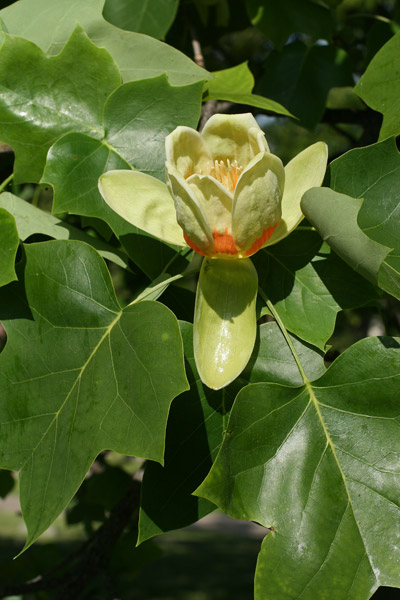
Liriodendron tulipifera
Greenlawn Cemetery, May 23, 2008
The flowers of Liriodendron are much like those of Magnolia, and are generally regarded, along with buttercups (family Ranunculaceae) and water-lilies (Nymphaceae), to be among the most primitive flowers. This can be conceptualized by recognizing that flowers are basically modified branches and that flower parts –sepals, petals, stamens, and pistils –are modified leaves on those branches. The flowers that most resemble a branch with leaves are regarded as most primitive. The made-up word “FENSH” is a guide to the features of primitive flowers.
“F” signifies “FREE,” as the flower parts are separate (free) from one another, i.e., they are not fused.
“E” stands for “EQUAL,” as the flower parts within a series are the same size and shape. i.e., the flowers are radially symmetric.
“N” means the flower parts (not the flowers themselves) are NUMEROUS.
“S” is for “SPIRAL,” as the numerous flower parts are spirally arranged.
“H” represents the HYPOGYNOUS nature of the first flowers, wherein the petals, sepals, and stamens rise away from the flower below the pistils. (This is also called having a “superior ovary.”)
Notice in the tulip-tree blossom. how the flower parts are separate, all the petals are the same size, the stamens are numerous and spirally arranged, and the pistils (which are also numerous and spirally aranged) are the topmost features. A FENSH flower, primitive.
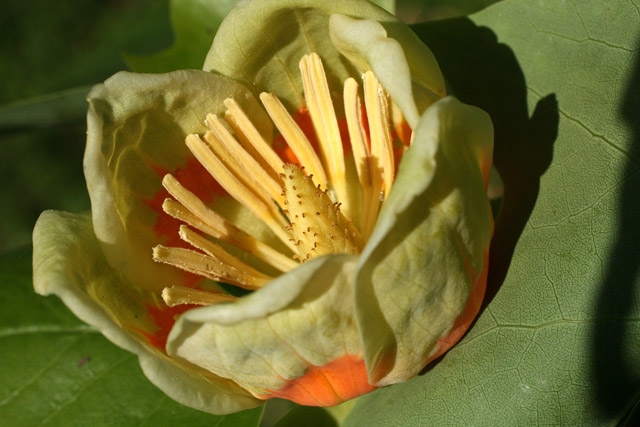
Tulip-tree flower
Greenlawn Cemetery, May 23, 2008
Covering a large stump sawed-off level with the ground and also scattered in the lawn nearby is an “inky cap” mushroom, in the genus Coprinus, maybe C. atramentareus. The inky caps have closely spaced narrow black gills that decompose into black liquid as (or perhaps after) they mature.
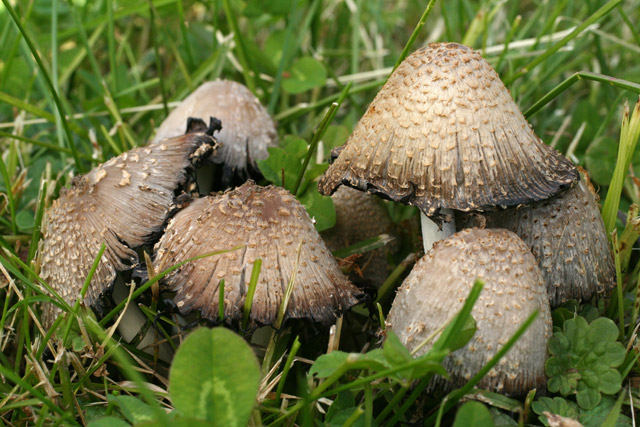
Inky-caps (genus Coprinus) at Greenlawn Cemetery, May 23, 2008.
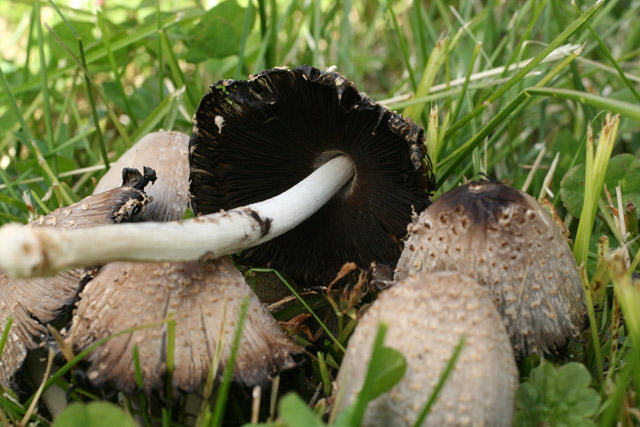
Inky-cap (genus Coprinus) have closely spaced narrow gills.
Greenlawn Cemetery, May 23, 2008, Columbus, OH
Before they go “inky,” the inky caps are edible, but some, such as this one, have an unususal side-effect. When consumed with alcohol, the result is intense nausea. This is caused by a chemical in the mushrooms related to the pharmaceutical medicine “antabuse,” used to treat alcohol dependency.
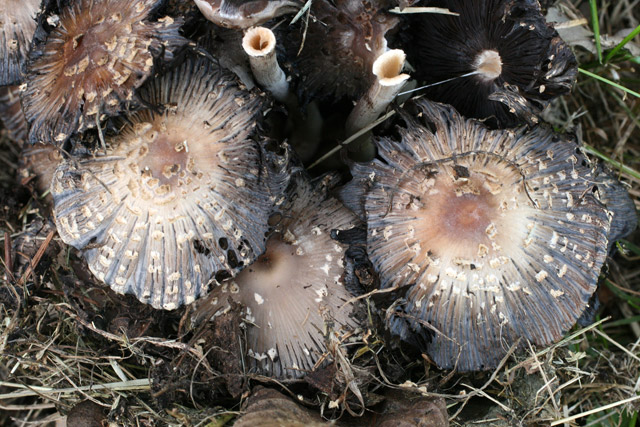
Inky-cap (genus Coprinus) gills at Greenlawn Cemetery, Columbus, OH
Douglas-fir (Pseudotsuga menziesii) is a magnificent forest tree of the Pacific northwest that rivals redwoods in height but is much more abundant. The familiar smell of plywood is the smell of “Doug-fir.” This is a member of the Pine family (Pinaceae) that can be a little hard to identify as its single (not clustered as in pines and larch) needles make it resemble a true fir (genus Abies) or a spruce (genus Picea). There are subtle differences in the leaves and twigs, but when they have cones, identification is super-easy. Douglas-fir cones have their papery bracts that are located above each woody cone scale extending far out from the scale. (In almost all other pine family members the bracts are shorter than the scales, hence they are not visible unless the cones are dissected.)

Douglas-fir with old seed cones
May 23, 2008, Greenlawn Cemetery, Columbus OH
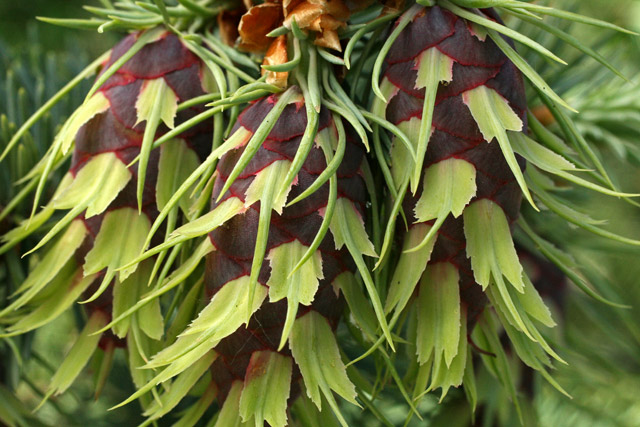
Douglas-fir young seed cones, May 23, 2008
Greenlawn Cemetery, Columbus, OH.
In Columbus (and elsewhere no doubt) a few small native woodland wildflowers have established themselves as lawn weeds. Spring-beauty, (Claytonia virginiana, family Montiaceae) is a good example. Several species of violets too grace lawns in some places. Here at Greenlawn, the striped creamy violet, Viola striata (family Violaceae) is especially abundant.
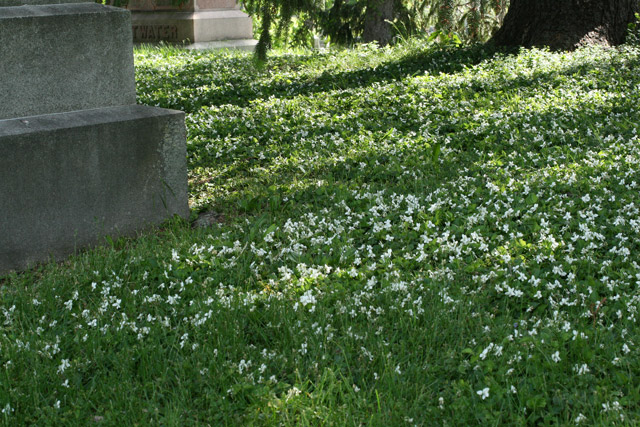
Viola striata patch in green lawn at Greenlawn Cemetery, May 23, 2008
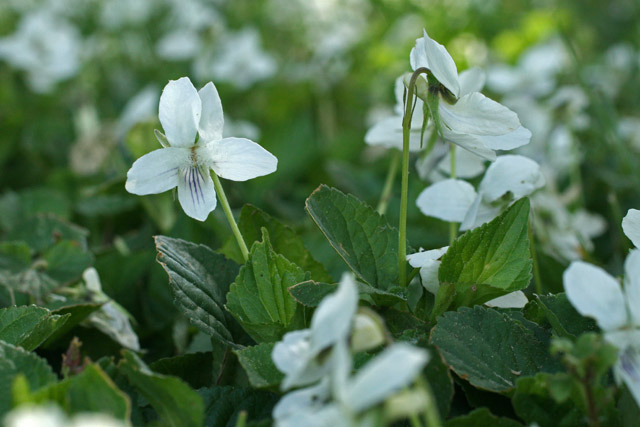
Viola striata, Greenlawn Cemetery, Columbus, OH May 23, 2008
